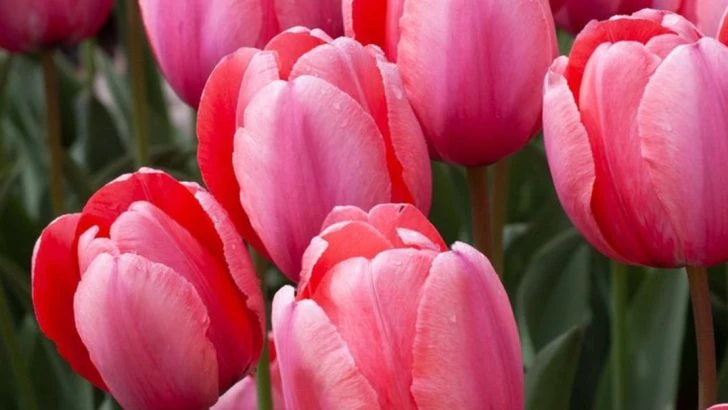After a long winter, the first signs of spring blooms bring a burst of color and life to the garden. If you’re eager to see flowers as early as possible, certain varieties thrive in the cool temperatures of early spring, giving your garden a head start on the growing season.
In this article, we highlight 23 flowers that bloom in early spring for those who can’t wait. From cheerful crocuses and daffodils to delicate hellebores and primroses, these blooms will brighten your yard before most plants even wake up. If you’re looking to add early-season color to your landscape, these flowers are the perfect choice!
Snowdrop
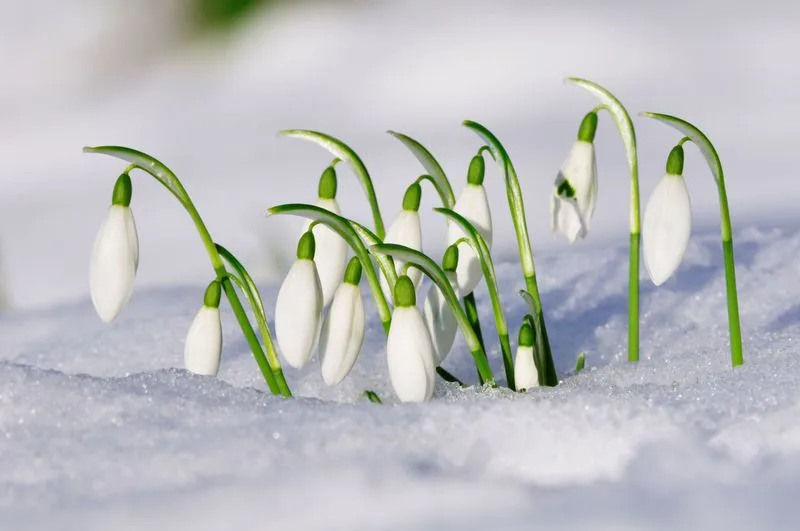
Emerging from the snow, snowdrops are one of the first signs of spring. Their small, white bell-shaped flowers hang gracefully, offering a subtle nod to the changing season. Plant them in clusters to create a stunning carpet of white in your garden. Hardy and resilient, snowdrops thrive in well-drained soil and partial shade. They are perfect for woodland gardens or under deciduous trees. These charming blooms symbolize hope and purity, reminding us that spring is just around the corner. Keep them happy by avoiding waterlogged conditions.
Crocus

Crocuses are a joyful addition to any early spring garden, with their bright purple, yellow, and white petals. These low-growing flowers often surprise gardeners by pushing through the last remnants of snow. Their cup-shaped blossoms open wide to the sun, attracting early pollinators. Plant crocuses in drifts across lawns or beneath shrubs for a naturalized effect. They thrive in full sun to part shade and prefer well-drained soil. Crocuses multiply readily, promising more color each year. Consider planting them in groups for maximum impact.
Winter Aconite
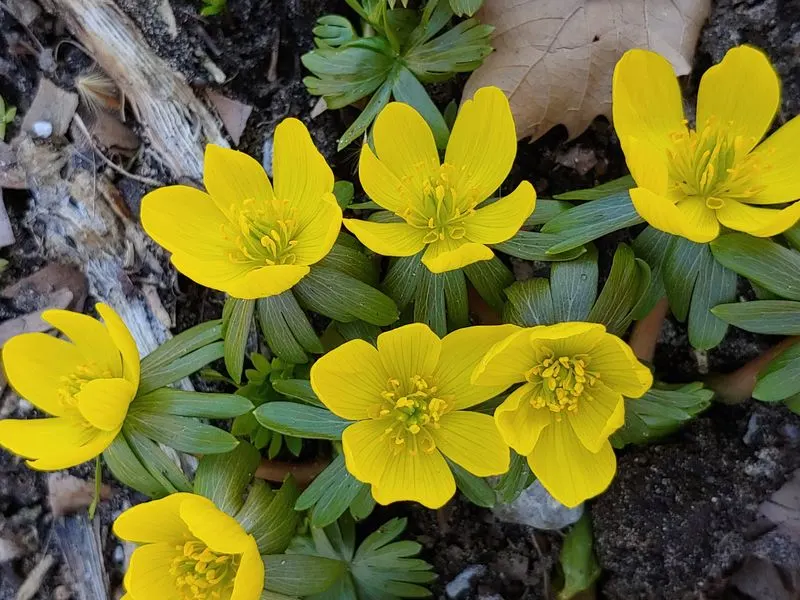
Brightening the winter landscape, winter aconites burst forth with sunny yellow flowers. These cheerful blooms offer a bold contrast to the muted tones of late winter. Perfect for naturalizing, they create a colorful carpet under trees and shrubs. Winter aconites prefer rich, well-drained soil and thrive in dappled sunlight. Their early flowering time makes them a crucial source of nectar for pollinators. These perennial plants are low-maintenance, self-seeding to ensure continued blooms year after year. Their resilience to cold provides an early hint of spring’s approach.
Daffodil
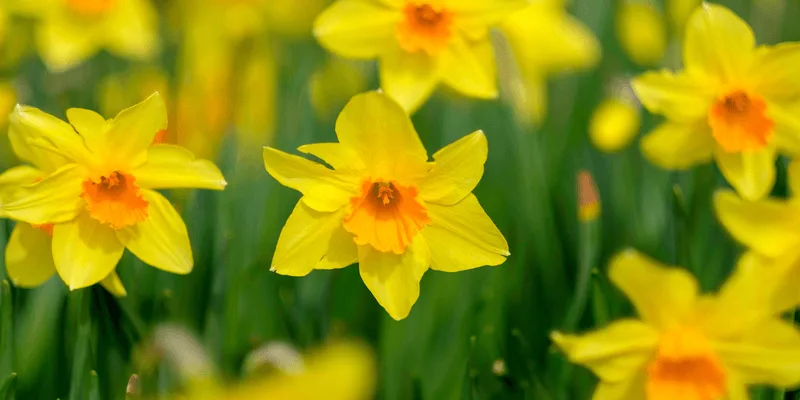
Daffodils herald the arrival of spring with their trumpet-shaped flowers in shades of yellow, white, and orange. These classic blooms are a symbol of renewal and optimism. Plant them in borders, containers, or naturalize them in lawns for a burst of color. Daffodils thrive in full sun to partial shade and prefer well-drained soil. Their deer-resistant nature makes them a garden favorite. As perennial bulbs, they return each year with more blooms, creating lasting beauty. Enjoy their cheerful presence and consider pairing them with tulips for a dynamic display.
Tulip
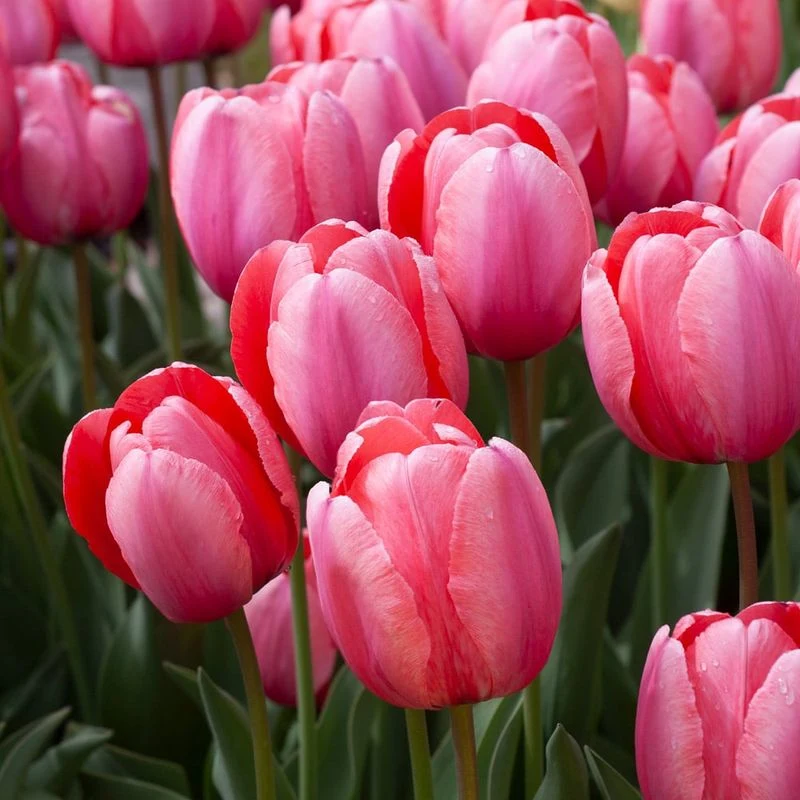
Tulips bring elegance and sophistication to the spring garden with their iconic cup-shaped blooms. Available in a myriad of colors and forms, they add a touch of class to any landscape. Plant tulips in well-drained soil and full sun for the best performance. These bulbs are perfect for creating stunning spring displays in beds, borders, and containers. Tulips are versatile, pairing beautifully with other spring bulbs like daffodils and hyacinths. For long-lasting blooms, plant them in groups and provide protection from strong winds. Enjoy their timeless beauty.
Hyacinth
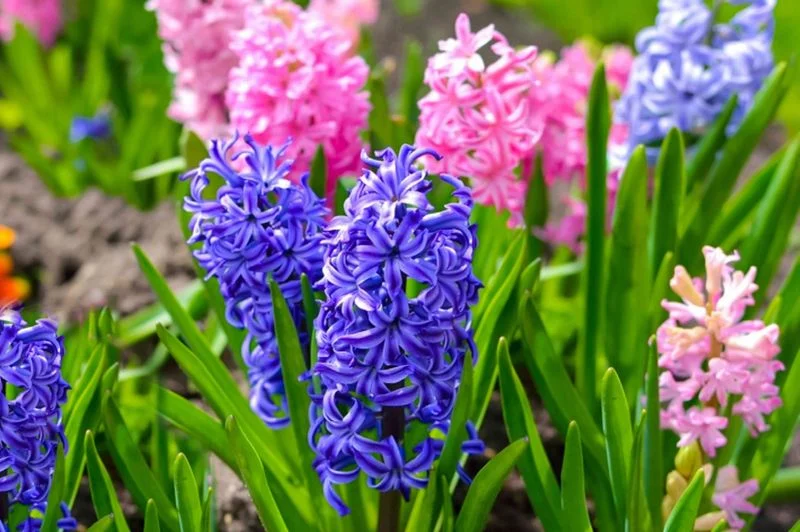
For fragrance and color, hyacinths are unparalleled. Their densely packed flowers come in a rainbow of hues, adding both beauty and scent to the spring garden. Plant hyacinths in sunny spots with well-drained soil to enjoy their full potential. They are excellent for borders and containers, where their sweet scent can be appreciated up close. Hyacinths also make wonderful cut flowers, bringing their delightful aroma indoors. As they return each year, consider adding more to your collection for an ever-expanding display. Avoid overwatering to prevent bulb rot.
Primrose
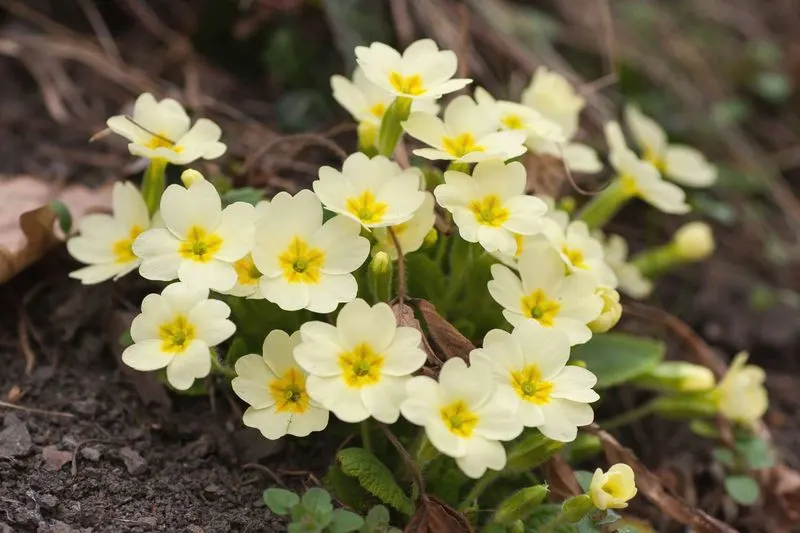
Primroses are a delightful harbinger of spring, with their vibrant colors and charming rosettes of flowers. These versatile plants thrive in partial shade and well-drained soil, making them ideal for woodland gardens. Primroses come in a variety of colors, from soft pastels to vivid hues, providing endless possibilities for garden design. Their low-growing habit makes them perfect for edging paths or filling in gaps between larger plants. With minimal maintenance, primroses reward gardeners with a long-lasting display of color. Deadhead spent flowers to encourage more blooms.
Grape Hyacinth
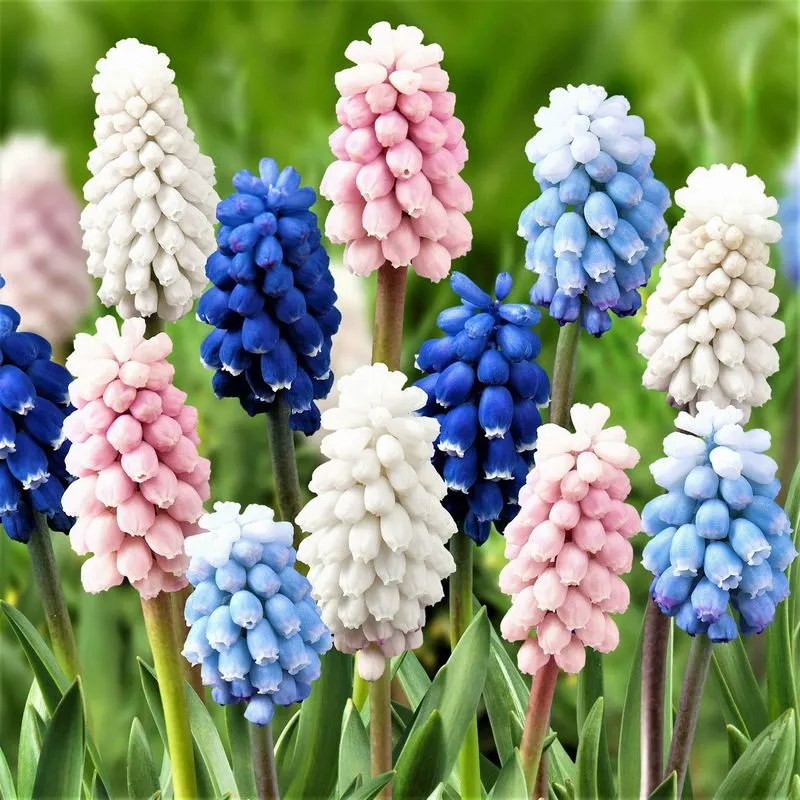
Grape hyacinths delight with their small, tightly packed clusters of blue or purple flowers. These diminutive yet striking blooms create a sea of color when planted in masses. Perfect for edging borders or filling in between other spring bulbs, grape hyacinths thrive in well-drained soil and full sun to partial shade. They are low-maintenance and naturalize easily, returning each spring with more flowers. Grape hyacinths attract pollinators and bring a touch of whimsy to the garden. Pair them with yellow daffodils for a complementary burst of color.
Hellebore
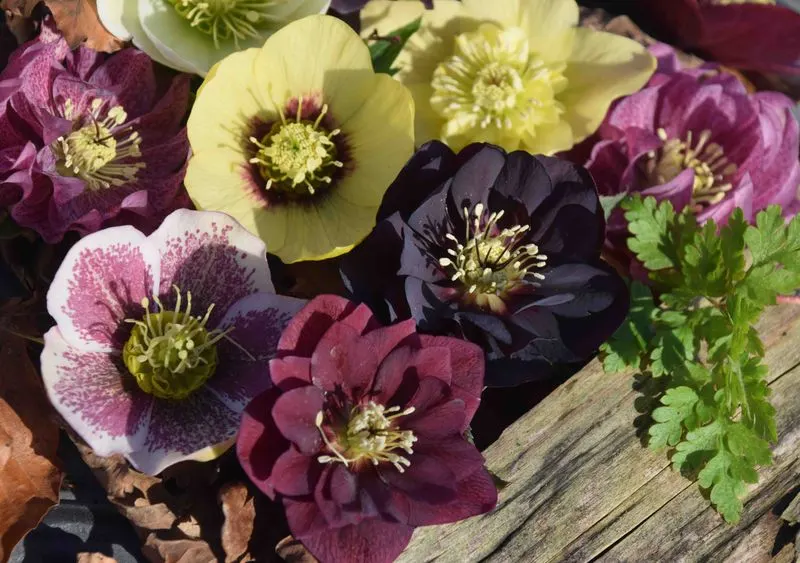
Hellebores, often called “Lenten roses,” bloom in the heart of winter, offering a preview of spring’s delights. Their nodding flowers appear in shades of white, pink, and green, adding elegance to shaded gardens. Hellebores prefer well-drained, rich soil and partial to full shade, making them ideal for woodland areas. These perennials are long-lived and deer-resistant, providing lasting beauty with minimal care. Hellebores are perfect for adding texture and interest to the garden, especially when paired with early spring bulbs. Enjoy their subtle charm as winter fades.
Iris Reticulata
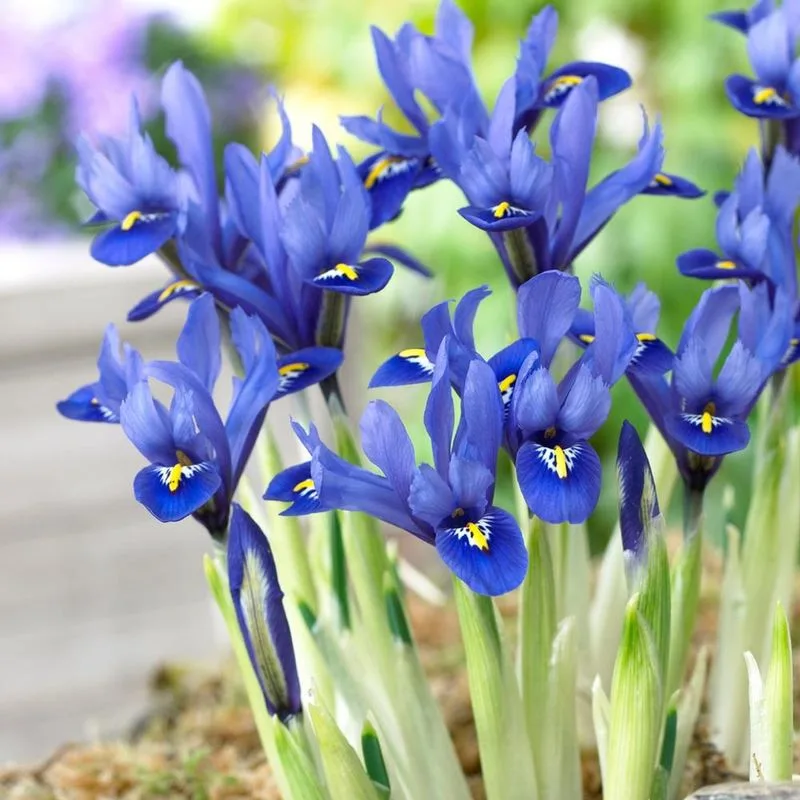
Iris Reticulata offers a splash of royal blue just as winter recedes. These small irises are perfect for rock gardens and border fronts. Their vibrant blue flowers with distinctive yellow markings stand out against the early spring landscape. They prefer well-drained soil and full sun, making them easy to grow in various settings. Iris Reticulata is ideal for naturalizing, with blooms returning year after year. Consider planting them in groups for a striking effect. Their compact size and early flowering make them a valuable addition to any garden.
Pansy
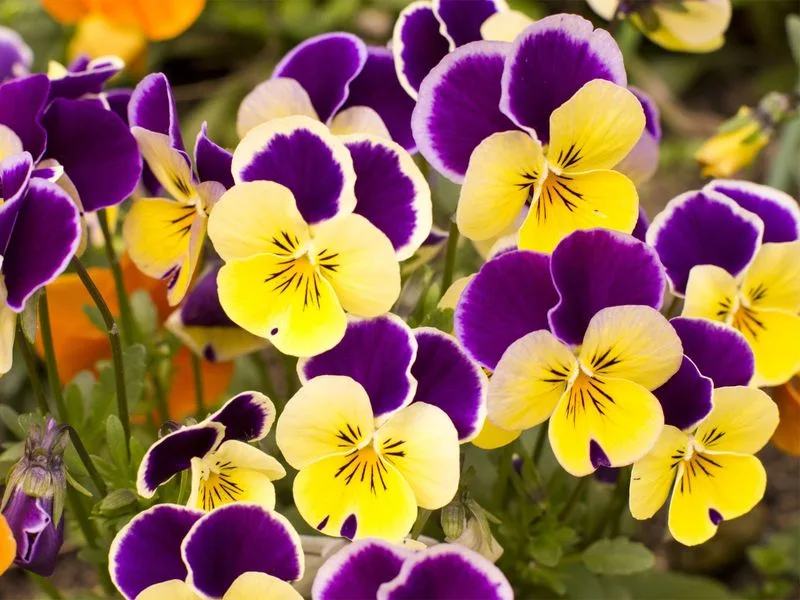
Pansies bring cheerful color to the garden with their distinctive ‘faces’ and wide range of hues. These cool-season favorites are perfect for containers, borders, and window boxes. Pansies thrive in well-drained soil and full sun to partial shade, providing a long season of blooms. Their versatility and variety make them ideal for adding color to any garden space. Pansies are also edible, adding a decorative touch to salads and desserts. Deadhead regularly to prolong blooming and enjoy their vibrant display throughout spring. Their charming appearance never fails to delight.
Anemone Blanda
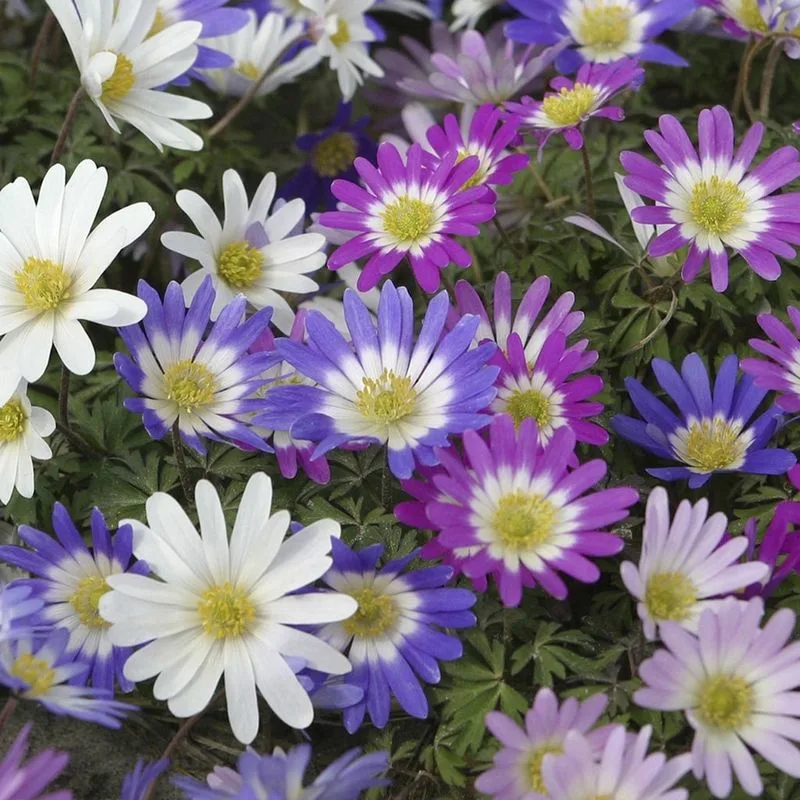
Anemone Blanda, known for its daisy-like flowers, adds a touch of wild beauty to the garden. These low-growing perennials bloom in shades of blue, white, and pink. Perfect for borders and rock gardens, they thrive in well-drained soil and full to part sun. Anemone Blanda naturalizes easily, creating a carpet of blooms that return each year. Their delicate flowers sway in the breeze, bringing movement and color to the landscape. Consider planting them in drifts for a natural effect. They are low-maintenance, requiring little more than occasional watering.
Glory of the Snow
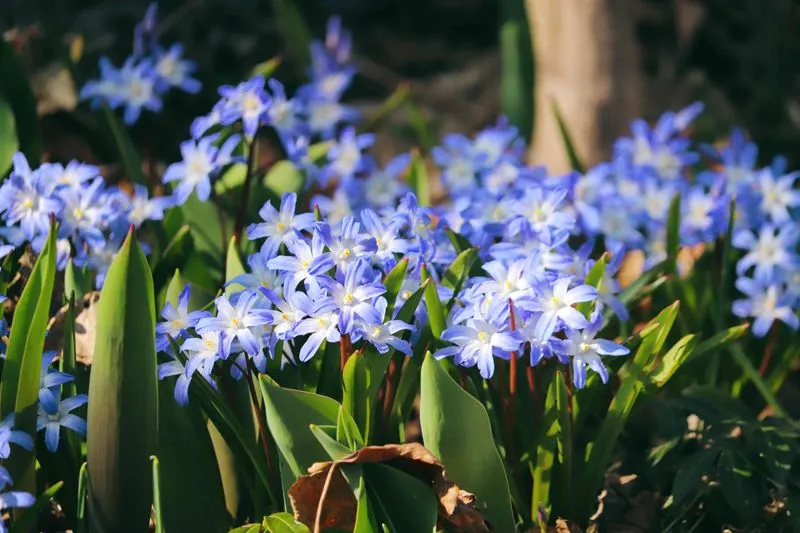
Glory of the Snow lives up to its name, emerging as snow recedes. These star-shaped blue flowers bring an early splash of color to the garden. Ideal for naturalizing, they excel in borders, rock gardens, and lawns. These bulbs prefer well-drained soil and full sun to partial shade. Glory of the Snow is low-maintenance, multiplying over time for an ever-increasing display. Their early blooms provide nectar for pollinators, supporting early insect life. Pair them with other early spring bulbs for a layered effect. Enjoy their charm as a herald of warmer days.
Chionodoxa
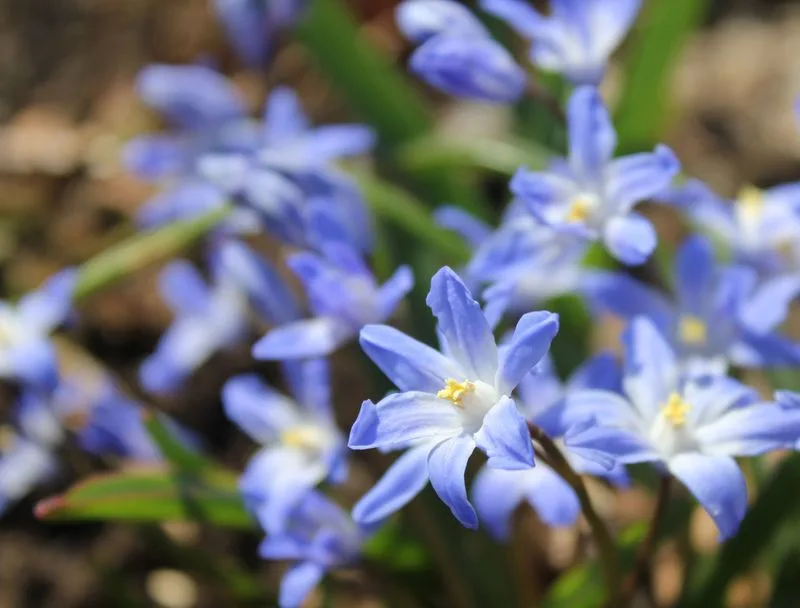
Chionodoxa, or “Glory of the Snow,” is a delightful addition to the spring garden. With its starry blue flowers and white centers, it brings a touch of brightness to the landscape. Perfect for naturalizing, Chionodoxa thrives in well-drained soil and full sun to partial shade. These bulbs are low-maintenance and multiply readily, returning each year. Plant them in drifts for a stunning carpet of color. Their early blooms provide an essential nectar source for pollinators. Chionodoxa pairs beautifully with other spring bulbs, adding depth and dimension to the garden.
Forsythia
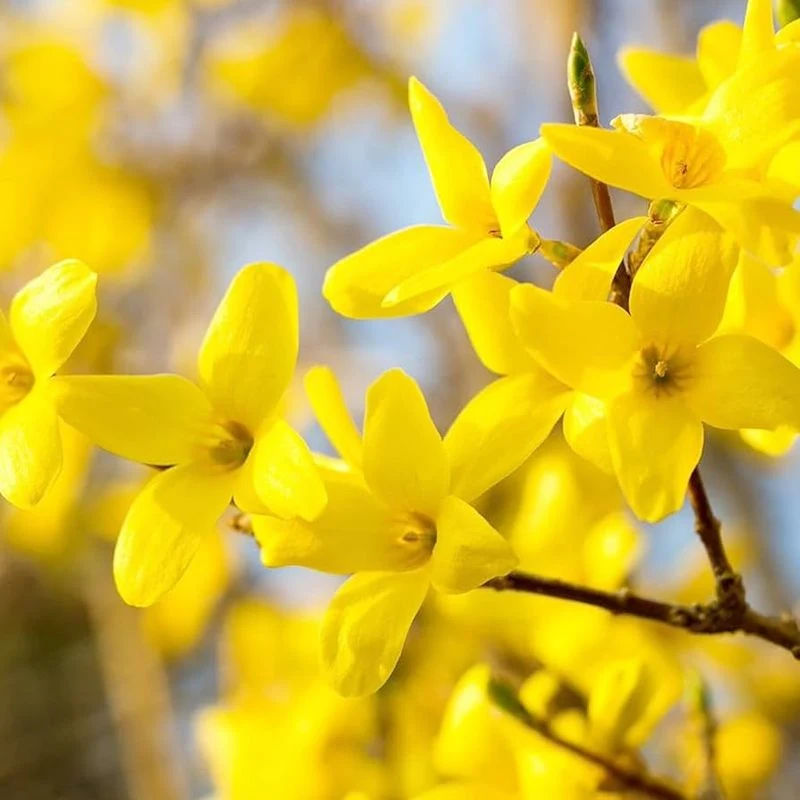
Forsythia bursts into bloom with a cascade of bright yellow flowers, often before the leaves appear. These shrubs are a beacon of spring, cherished for their vibrant, cheerful display. Forsythia thrives in well-drained soil and full sun, making them ideal for borders and hedges. They require minimal care, only needing occasional pruning to maintain shape. Forsythia’s bold color and early blooms make it a focal point in the garden. Cut branches can be forced indoors for an early taste of spring. Enjoy their exuberant presence and lively charm.
Scilla
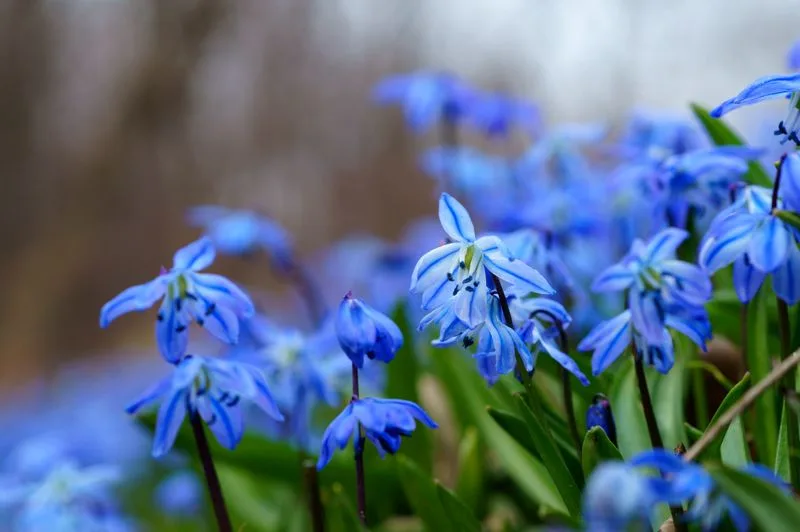
Scilla, also known as squill, enchants with its bright blue bell-shaped flowers. These hardy perennials thrive in well-drained soil and full sun to partial shade. Scilla is perfect for naturalizing, spreading easily to form carpets of color. Their early blooms provide a vital nectar source for pollinators. Plant Scilla in drifts under trees or in rock gardens for a stunning effect. They are low-maintenance and return each year with more flowers. Consider pairing them with daffodils for a vibrant contrast. Scilla’s delicate beauty adds grace to the spring garden.
Puschkinia
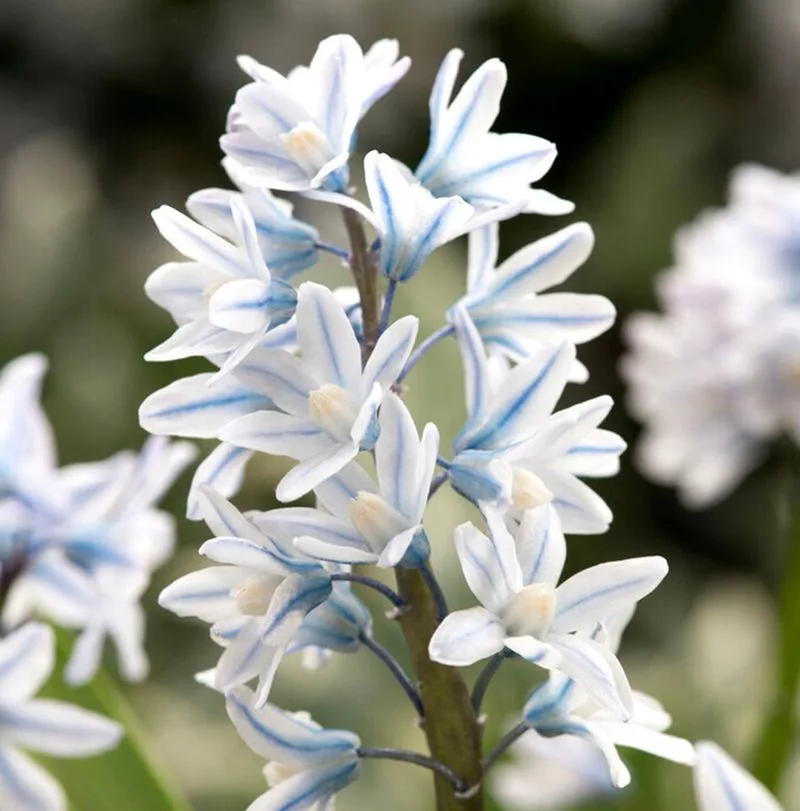
Puschkinia, or striped squill, captivates with its delicate pale blue flowers adorned with darker stripes. These charming bulbs thrive in well-drained soil and full sun to partial shade. Puschkinia is ideal for rock gardens, borders, and naturalizing. Their early blooms attract pollinators and provide a soft, subtle touch to the spring landscape. Plant them in groups for a cohesive look that enhances their beauty. Puschkinia’s easy-care nature makes them a favorite among gardeners. Their understated elegance adds a gentle grace to any garden setting.
Violet
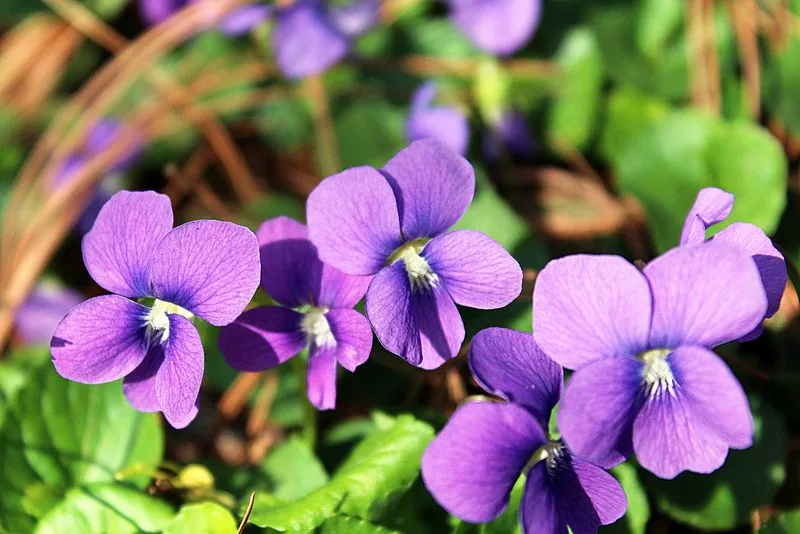
Violets add a sweet touch to the garden with their delicate flowers and heart-shaped leaves. These charming perennials are perfect for shaded areas, thriving in well-drained soil and dappled sunlight. Violets come in shades of purple, blue, and white, adding variety to the garden palette. Their fragrance and beauty make them a timeless favorite. Violets are low-maintenance and spread easily, offering a ground cover solution for challenging spots. Consider using them alongside other shade-loving plants for a cohesive look. Their gentle allure never fails to enchant.
Lungwort
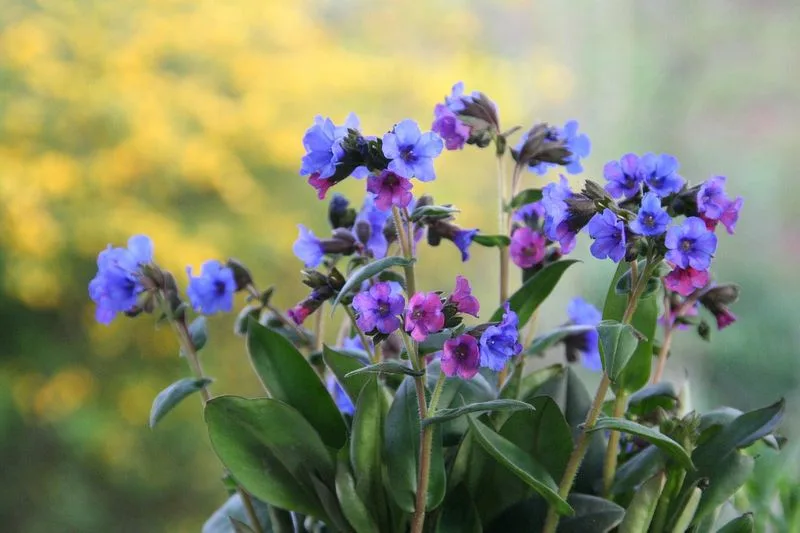
Lungwort, known for its spotted leaves and changing flower colors, brings texture and color to the shaded garden. Flowers open pink and mature to blue, creating a lovely two-tone effect. Lungwort thrives in well-drained soil and partial to full shade, making it perfect for woodland gardens. These perennials are low-maintenance and deer-resistant, adding lasting interest with minimal care. Lungwort’s unique foliage provides contrast and structure, while its flowers attract early pollinators. Pair them with ferns and hostas for a dynamic shade garden. Their distinctive charm is truly captivating.
Wood Anemone
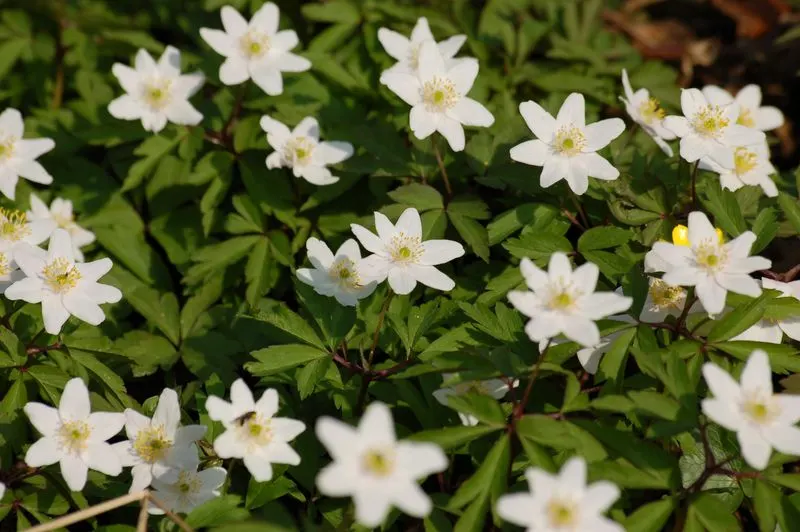
Wood anemones, with their delicate white flowers, bring a touch of wild grace to the spring garden. These perennials thrive in shaded woodland areas, preferring well-drained soil and dappled light. Wood anemones naturalize easily, spreading to form carpets of blooms. They are low-maintenance and return each year, enhancing the garden’s natural charm. Their simple beauty and delicate petals sway gently in the breeze. Consider pairing them with other woodland plants for a cohesive look. Their understated elegance and resilience are a testament to nature’s beauty.
Siberian Squill
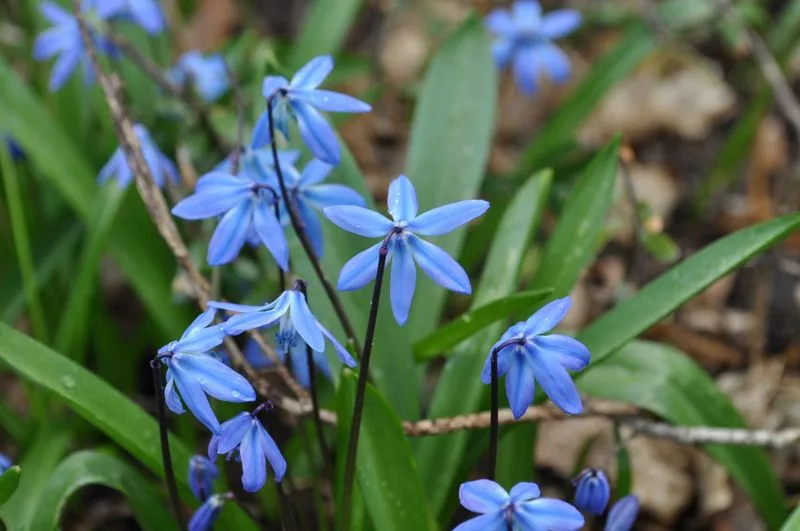
Siberian Squill enchants with its bright blue star-shaped flowers, bringing early spring color to the garden. These bulbs thrive in well-drained soil and full sun to partial shade. Perfect for naturalizing, Siberian Squill spreads easily, forming vibrant carpets of blooms. They are low-maintenance and return each year, providing reliable color. Siberian Squill attracts pollinators, supporting the early spring ecosystem. Plant them in drifts for a stunning effect, pairing with other early bloomers for a rich tapestry of hues. Their vivid blue adds a striking touch to any landscape.
Camellia

Camellias, with their glossy green leaves and exquisite blooms, add sophistication to the garden. These shrubs bloom in shades of pink, red, and white, offering a long season of interest. Camellias thrive in well-drained, acidic soil and partial shade, making them ideal for woodland gardens. Their flowers, often compared to roses, are perfect for adding elegance to borders and containers. Camellias require minimal pruning and care, rewarding gardeners with abundant blooms. Their classic beauty and enduring charm make them a beloved choice for spring gardens. Enjoy their graceful presence.
English Bluebell

English Bluebells create a breathtaking spectacle with their nodding, bell-shaped flowers. These perennials thrive in wooded areas, preferring well-drained soil and partial shade. Bluebells naturalize easily, forming dense carpets of vibrant color. They are low-maintenance and return each year, enhancing the garden’s natural allure. Their fragrant blooms attract pollinators, supporting early spring wildlife. Consider planting them under deciduous trees for a naturalized effect. English Bluebells’ enchanting beauty and gentle fragrance make them a cherished addition to any spring garden. Their timeless appeal is undeniable.

